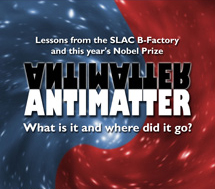
Handy Links
SLAC News Center
SLAC Today
- Subscribe
- Archives: Feb 2006-May 20, 2011
- Archives: May 23, 2011 and later
- Submit Feedback or Story Ideas
- About SLAC Today
SLAC News
Lab News
- Interactions
- Lightsources.org
- ILC NewsLine
- Int'l Science Grid This Week
- Fermilab Today
- Berkeley Lab News
- @brookhaven TODAY
- DOE Pulse
- CERN Courier
- DESY inForm
- US / LHC
SLAC Links
- Emergency
- Safety
- Policy Repository
- Site Entry Form

- Site Maps
- M & O Review
- Computing Status & Calendar
- SLAC Colloquium
- SLACspeak
- SLACspace
- SLAC Logo
- Café Menu
- Flea Market
- Web E-mail
- Marguerite Shuttle
- Discount Commuter Passes
-
Award Reporting Form
- SPIRES
- SciDoc
- Activity Groups
- Library
Stanford
Around the Bay
Antimatter: What is It and Where Did It Go?
Lessons from the SLAC B Factory and This Year's Nobel Prize
SLAC physicist Aaron Roodman kindly agreed to provide this summary of his October 28 public lecture.
All elementary particles, such as electrons, protons and neutrons, have an antimatter version. For example, the anti-electron is exactly the same as the electron, but it has the opposite electric charge; likewise the anti-proton is just like the proton, again with opposite charge. But the Universe is just made up of matter, with virtually no anti-matter. If there were antimatter galaxies or stars there would be regions of space where antimatter and matter are annihilating each other, but this has not been observed. Why is there no antimatter in the universe?
Theory predicts that just after the Big Bang there must have been equal amounts of matter and antimatter. Early in the Universe there must have been some interaction between elementary particles that differed between matter and antimatter, and that produced a small excess of matter over antimatter. Then all the antimatter annihilated with most of the matter, leaving a small excess of matter and lots of energy. That small excess of matter is all the galaxies, stars, planets in the universe—it is us.
There are four forces in nature: the strong nuclear force, electromagnetism, the weak force and gravity. But only the weak force differs between antimatter and matter. It is response for some radioactive decays, but otherwise has little impact in our daily lives. In 1964, a matter versus antimatter difference, or asymmetry, was discovered in weak interaction decays of a subatomic particle called the neutral K meson. In 1973, two Japanese physicists, Kobayashi and Maskawa, proposed that the weak force could cause a matter-antimatter asymmetry. Their model called for the existence of at least six types of quarks, though only three were known at the time. It also predicted that large differences between matter and antimatter would exist in decays of a specific particle, the B meson, the meson containing a b quark. Over time, the other three quarks have been discovered, but the model's predictions for the B meson could not be observed.
The SLAC B Factory was built to search for matter-antimatter asymmetries in the B meson. The B Factory's BaBar experiment detected matter-antimatter differences by measuring the decays of both matter and antimatter B mesons and looking for interference patterns that could signal asymmetries between the two. The B meson is five times heavier than a proton, so it can decay literally thousands of different ways. Because of the many decay possibilities, it is possible to observe many different matter-antimatter asymmetries at the B Factory.
The B Factory was designed to answer two key questions: 1) How does the weak interaction cause a matter-antimatter asymmetry? and 2) Is the matter-antimatter asymmetry in B mesons just from the weak force, or is another new force also involved? Using many other weak force measurements and the Cabibbo-Kobayashi-Maskawa model, BaBar scientists started with a prediction for the size of matter-antimatter asymmetries in B meson decays, hoping to confirm the CKM model and answer question #1. Ironically, due to the complicated processes that must be involved, the weak force alone is not enough to produce the excess of matter over antimatter in the early Universe. Another force is needed, one that probably involves more massive and as yet undiscovered particles. If physicists observe an unexpected matter-antimatter asymmetry, this new source of asymmetry could be responsible for the disappearance of antimatter.
The SLAC B Factory produced B mesons for nine years, and almost a billion B mesons were observed by the BaBar experiment. The data showed a large matter-antimatter asymmetry when the neutral B meson decays to the particle J/Psi and a neutral Kaon. The size of this asymmetry is a very good match to that expected—strong evidence that the theory of how the weak force causes matter-antimatter asymmetries is correct. The 2008 Nobel Prize in Physics was awarded to Kobayashi and Maskawa, who first proposed how the weak force could explain such asymmetries. The evidence provided by BaBar, and another experiment in Japan called BELLE, was cited by the Nobel committee as the key proof of Kobayashi and Maskawa's model. However, since the source of the preponderance of matter over antimatter in the Universe is still a mystery. Babar is continuing to explore other matter-antimatter differences.
—Aaron Roodman
SLAC Today, December 11, 2008
